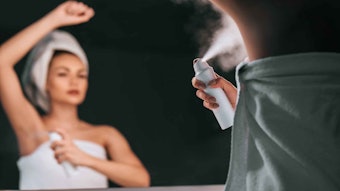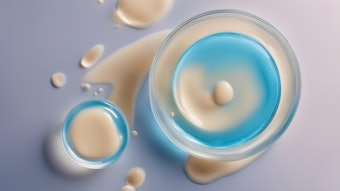
It started with the best of intentions for consumer safety: the U.S. Food and Drug Administration (FDA) advised that sunscreen actives with a systemic absorption greater than 0.5 ng/mL or with safety concerns should undergo nonclinical toxicology assessment.
Tests were then carried out to determine whether sunscreens were absorbed and if so, which ones were present at levels requiring systemic carcinogenicity and additional developmental and reproductive studies. But flaws in the test design appear to have rendered the results inconclusive at best.
Study Protocol
According to the study, published in the Journal of the American Medical Association, researchers sought to determine whether the sunscreen actives avobenzone, oxybenzone, octocrylene and ecamsule were absorbed into systemic circulation. In total, 24 subjects (three men and three women in each of four test groups: spray 1, spray 2, lotion and cream) with a mean age of 35.5 stayed in a clinic for up to seven days of testing.
The study products were weighed in advance and applied by a qualified team member. Two milligrams of sunscreen per 1 cm2 was applied to 75% of body surface area, i.e., the area outside of normal swimwear, four times per day for for days; reportedly since sunscreens are labeled to be applied at least every two hours and may be applied for multiple days in a row, such as might occur when outside in the sun.
Plasma concentrations of each active ingredient were assessed with validated liquid chromatography using tandem mass spectrometry methods. Thirty blood samples were collected for each subject.
Study Results
The application of all four commercially available sunscreens under said maximal use conditions resulted in plasma concentrations exceeding the threshold of 0.5 ng/mL established by the FDA for waiving some nonclinical toxicology studies.
According to the researchers, the observed systemic absorption of sunscreen ingredients supports the need for further studies to determine the clinical significance of these findings, although these results do not indicate individuals should refrain from using sunscreen. The most common adverse event was a rash, which developed in one participant with each sunscreen.
"I think this study has too many flaws and is based on
too small a panel to make the comments and
[conclusions] being made."
Flaws in the Study: An Expert Opinion
In response to the alarm this paper has generated, Cosmetics & Toiletries sought an expert's opinion on the study and its broader implications. The following outlines David C. Steinberg's, of Steinberg & Associates, written responses as he read through the paper.
"This paper was released on May 6, 2019, in the JAMA with the corresponding author of David G. Strauss, M.D., Ph.D., of the FDA.
"It is clear to me that this article was reporting on research performed by the FDA and used by the FDA on its Federal Register publication of Feb. 26, 2019, on new Proposed Rules for Sunscreen Drug Products. The design of the experiment was based on a very small panel, i.e., six subjects per sunscreen, and applying an amount that almost no consumer has ever applied or even come close to applying.
"Further, the repeated application is part of the FDA’s regulations for labeling sunscreens but this is almost never followed by consumers. How many people have you ever seen at the beach go indoors after two hours, reapply sunscreen, then wait at least 15 min before going out into the sun again?
"The test products were two sprays and one cream and one lotion. These included only the following filters: avobenzone, oxybenzone, octocrylene and ecamsule (note: ecamsule is not an OTC Monographed drug but has been approved via an NDA submitted by L’Oréal).
"The first paragraph of this paper says, 'For some individuals, sunscreen products may be applied in substantial amounts multiple times every day over the course of a lifetime as both primary sunscreen products, starting from an age of six months, and as ingredients in cosmetic products.' This statement is a [completely false assumption].
"Further, the test only applies the products in a manner mandated by the FDA to test sunscreens in order to obtain the SPF of the product. The amount applied is 2 mg/cm2—a level almost no consumer ever applies. The FDA directions for testing also require a waiting period of 15 min after application, and using a finger cot to evenly spread the product. Then, the test area is exposed to a set level of radiation and read 16 to 24 hr after application.
"Consumers typically only apply approx. 0.5 mg/cm2. They also do not use finger cots or wait before going out into the sun; especially during beach use. The FDA directions for sunscreen application state: Non-Water Resistant Product • apply liberally 15 minutes before sun exposure • use a water resistant sunscreen if swimming or sweating • reapply at least every 2 hours • children under 6 months: Ask a doctor.
"The use of sunscreen active ingredients in cosmetics also is not relevant to this study. Excluding titanium dioxide, the use of permitted filters in cosmetics (not claiming SPF or any sun protection) is limited to very low levels of UV filters, to protect colors and fragrances from degradation when exposed to the sun. Typical levels are below 1% and are not subject to dosages or reapplications as described above.
While the major oversights in study design call for additional studies with proper controls and benchmarks, the damage to the industry may already be done.
"Titanium dioxide is an important cosmetic ingredient but not for UV protection. It is a white pigment used for its color in cosmetics such as makeup, eye shadow, lipstick and nail polishes. Can you image any consumer reapplying lipstick every 2 hr after applying 2 mg/cm2 and waiting 15 min after application to go out in the sun?
"The paper continues on with the claim that UV filters penetrate the skin. This shows that the scientist involved in this study has never formulated a sunscreen in his/her life. Just look at the four filters:
- Avobenzone: Whose melting point is usually specified as 81-86°C. Think of putting this on your skin and seeing how much penetrates.
- Oxybenzone: Whose melting point is 62°C. Same comments as above.
- Octocrylene: Which has a melting point of about 14°C; and
- Ecamsule: Whose melting point is 255°C, at which point it decomposes. In fact, this is not a UV filter, it is an acid; when neutralized to a salt it becomes a UV filter.
"So, if the FDA is so concerned about these penetrating the skin, why did they not test the pure chemicals? Because they need to be tested in the actual sunscreen setting. Also, the FDA purchased actual products for these tests and did not reveal the labeled SPF, water resistance, inactive ingredients, etc. What they failed to understand is how you dissolve these chemicals and make emulsions or sprays.
"The sprays are another question, as the report says the amount used was weighed for the study. But what happened to the volatile propellants? If they evaporated, the levels of everything remaining increased. The FDA was aware of this consideration as in 2007, it asked in a Federal Register (FR) notice whether sprays (and other forms of sunscreens) should be tested for SPF (and UVA) using the methods previously published.
"The next FR publication gave sprays a 'free ride' even though the FDA received no comments or suggestions regarding this issue. The FDA has tried to ban other methods of applying sunscreens to the skin but only those formulating cleansing formats, which are washed off before exposure to the sun, submitted a methodology that would be applicable.
"This paper is further flawed by not listing all ingredients, and whether water resistant or very water resistant was claimed. Were there oil-soluble polymers in the formulation, and how did this affect skin penetration? These are typically added to pass the FDA method for claiming water resistance. They act as a barrier to prevent the UV filters from washing off by water exposure alone, but also may prohibit skin penetration by the UV filters.
"The same critical question must be asked regarding solvents in the oil phase. Do the individual solvents penetrate the skin, and can they carry UV filters through the skin? It is also critical to determine the solubility parameters of the oil phase and the required solubility parameter of each UV filter. This requires knowledge of how to formulate a sunscreen.
"I think this study has too many flaws and is [based on too small a panel] to make the comments and [conclusions] being made, especially without disclosing all the ingredients. Furthermore, I question how any peer reviewer on this paper allowed it to be published; unless they lacked the knowledge to understand all these issues."
Broader Implications
While the major oversights in study design call for additional studies with proper controls and benchmarks, the damage to the industry may already be done. Consumer media has picked up the story, alarming users based on inconclusive data.
This is certainly not the first time we've seen it happen. Take oxybenzone, for example, which is in the hotseat over alleged negative effects to coral reefs. No doubt the ebb and flow of consumer demand, and therefore industry direction, will soon sway back toward physical sunscreens.










